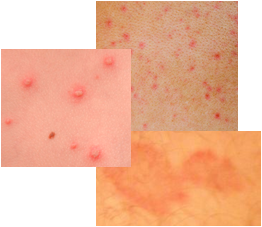Granuloma Annulare
Visit this
PICTURES OF RASHES PAGE
Symptoms
Granuloma annulare (GA) is a chronic skin condition first described as far back as 1895 and is characterized by a rash on the skin that can be raised, bumpy, and red, purple, skin-colored, or pink. The bumps can be up to 3 mm in size and found singly or in groups arranged in the shape of a circle or ring up to 5 cm in size and with a clear center. Because of the ring pattern, GA is often mistaken as being a ringworm rash problem. Common insect bites may also be confused as GA and well as Lyme disease.
This skin condition affects females more than males. In fact the frequency is twice as many females being affected than males. In terms of age, children and young adults (younger than 30 years of age) suffer from these lesions more than older adults, although it is also fairly common in older adults as well. Skin areas targeted by granuloma annulare include the back of the hands and tops of the fingers, around the elbows and knees, and the top of the feet. Some itching may be experienced by individuals with this type of skin rash problem, although usually no itching or skin peeling is evident and the affected individual does not show other signs of illness.
For the most part, GA does not have a long-term impact on health, but the skin rash can cause stress due to the appearance of the skin. Generalized granuloma annulare is more problematic because it affects a greater skin area, with the appearance of rings over most of the body and itching being more prominent.
Diagnosis and Causes
The causes for GA are basically unknown although some evidence indicates links to health conditions such as diabetes, thyroid disease, tuberculosis, insect bites and other skin trauma, sun exposure, and viral infections.
Granuloma annulare is diagnosed by a dermatologist by visual appearance or by ruling out the presence of skin fungus and therefore ringworm. A skin biopsy with subsequent examination of the sample under a microscope can prove whether GA is present or not.
Granuloma Annulare Treatment Options
Since GA is not a serious health problem and often does not produce irritating symptoms, treatments are not usually necessary or sought after. In many cases, the bumpy rash disappears on its own (in a few months or possibly a couple of years) and leaves behind no marks on the skin or scars. Some statistics show that 70% of individuals with GA will have the skin rash disappear within 2 years with no treatment. In 40% of the cases, GA returned to the same skin site that was previously affected.
On the other hand, because of the appearance of granuloma annulare on the skin, many people do desire a treatment as opposed to waiting it out and living with the skin disfiguration. Options for treatment include the use of steroidal creams, steroidal ointments, steroidal injections, ultraviolet light therapy (PUVA – which combines ultraviolet A light with psoralen drugs), oral medications, cryotherapy or freezing the lesions with liquid nitrogen and then removing them, laser therapy, and non-steroidal anti-inflammatory creams.
skin care | diagnose my skin rash | strep rash | syphilis rash | tinea versicolor skin discoloration rash | lupus rash | shingles rash | chicken pox rash | hiv rash | stress rash | bug bites or insect bites or stings | poison ivy rash | food allergy rash | lamictal rash | nair rash | niacin skin rash
